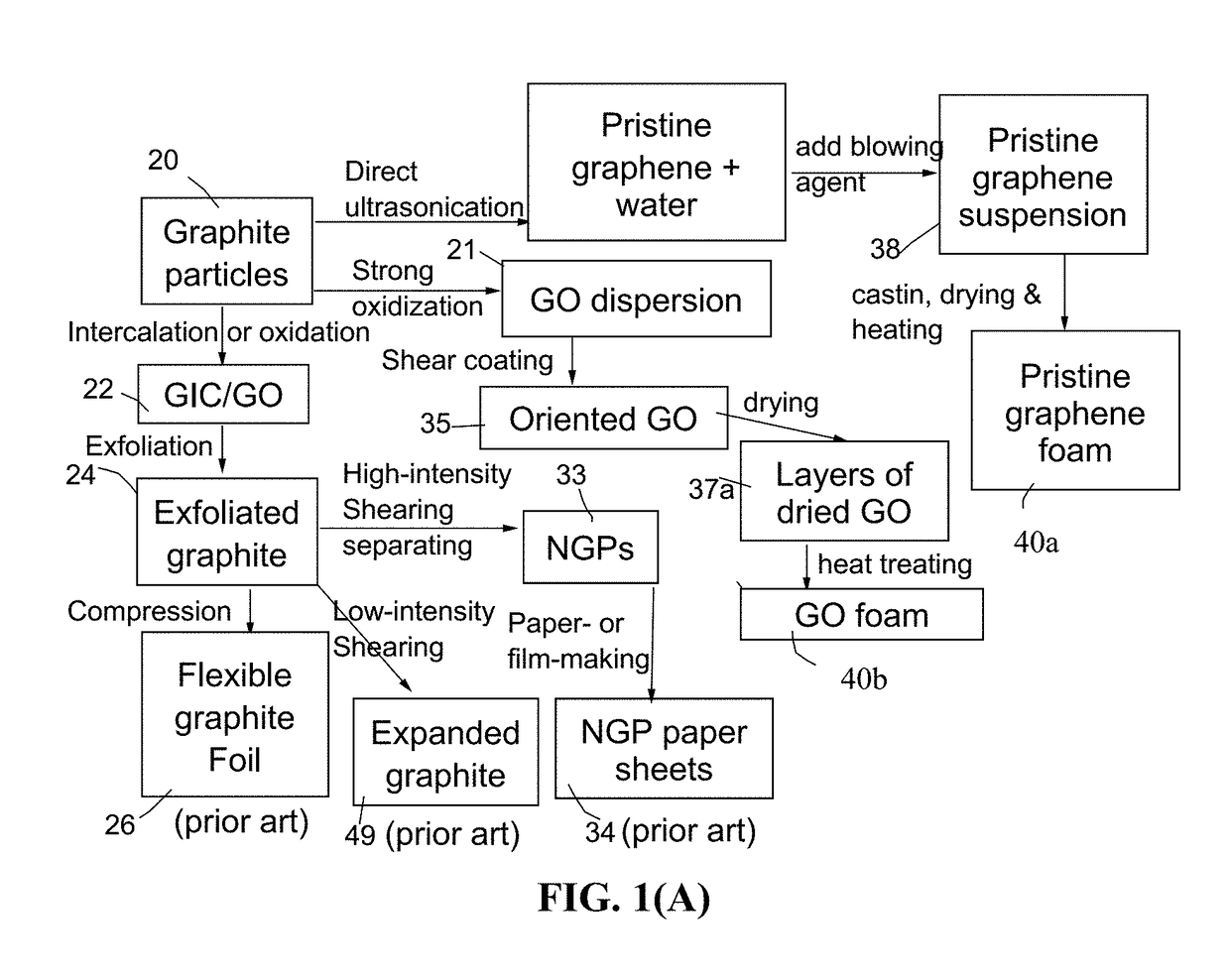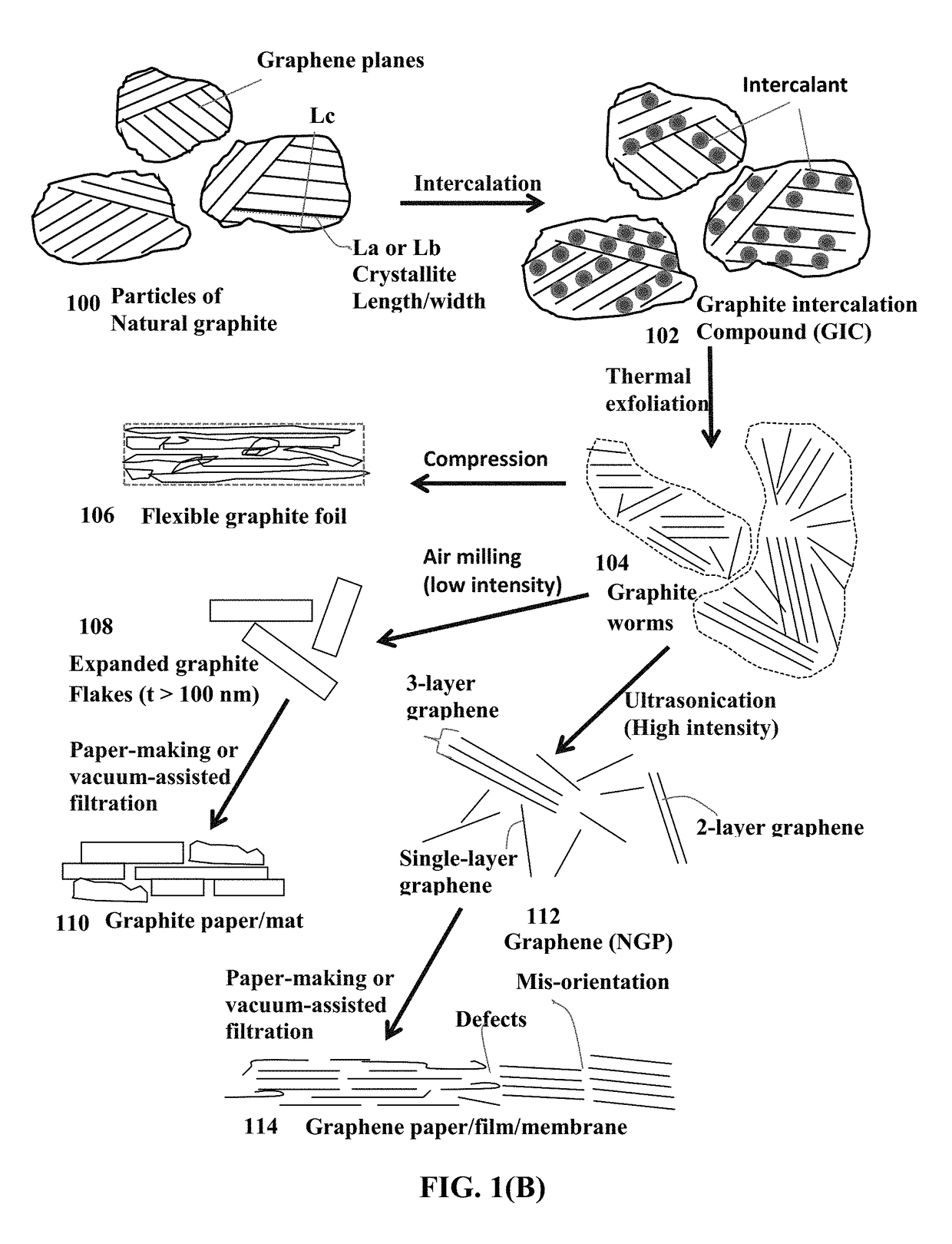Supercapacitor electrode having highly oriented and closely packed expanded graphite flakes and production process
a supercapacitor and graphite flakes technology, applied in the field of supercapacitors, can solve the problems of low actual mass loading of the electrode and the apparent densities of active materials, poor structural integrity, and inability to provide high-capacity energy storage devices at the supercapacitor cell or pack level, so as to improve the orientation of graphite flakes and reduce the thickness
- Summary
- Abstract
- Description
- Claims
- Application Information
AI Technical Summary
Benefits of technology
Problems solved by technology
Method used
Image
Examples
example 1
on of Exfoliated Graphite Worms and Expanded Graphite Flakes from Meso-Carbon Micro-Beads (MCMBs)
[0101]Meso-carbon microbeads (MCMBs) were supplied from China Steel Chemical Co., Kaohsiung, Taiwan. This material has a density of about 2.24 g / cm3 with a median particle size of about 16 μm. MCMB (10 grams) were intercalated with an acid solution (sulfuric acid, nitric acid, and potassium permanganate at a ratio of 4:1:0.05) for a period of time from 4 hours up to 48 hours. Upon completion of the reaction, the mixture was poured into deionized water and filtered. The intercalated MCMBs were repeatedly washed in a 5% solution of HCl to remove most of the sulphate ions. The sample was then washed repeatedly with deionized water until the pH of the filtrate was no less than 4.0. The slurry was then dried in a vacuum for 24 hours to obtain a graphite intercalation compound (GIC).
[0102]The GIC was then thermally exfoliated at 650° C. for 1 minute to produce exfoliated graphite worms, which ...
example 2
on of Exfoliated Graphite Worms and Expanded Graphite Flakes from Short Graphite Fibers
[0103]Chopped graphite fibers with an average diameter of 12 μm and natural graphite particles were separately used as a starting material, which was immersed in a mixture of concentrated sulfuric acid, nitric acid, and potassium permanganate (as the chemical intercalate and oxidizer) to prepare graphite intercalation compounds (GICs). The starting material was first dried in a vacuum oven for 24 h at 80° C. Then, a mixture of concentrated sulfuric acid, fuming nitric acid, and potassium permanganate (at a weight ratio of 4:1:0.05) was slowly added, under appropriate cooling and stirring, to a three-neck flask containing fiber segments. After 4 hours of reaction, the acid-treated graphite fibers or natural graphite particles were filtered and washed thoroughly with deionized water until the pH level of the solution reached 6. After drying the product at 100° C. overnight, we obtained a graphite in...
example 3
on of Exfoliated Graphite Worms and Electrodes from Natural Graphite
[0107]Graphite intercalation compound or graphite oxide was prepared by oxidation of natural flake graphite with an oxidizer liquid consisting of sulfuric acid, sodium nitrate, and potassium permanganate at a ratio of 4:1:0.05 at 30° C. When natural graphite flakes (particle sizes of 25 m) were immersed and dispersed in the oxidizer mixture liquid for 4 hours, the suspension or slurry remains optically opaque and dark. After this, the reacting mass was rinsed with water 3 times to adjust the pH value to at least 3.0. The mass was then dried in a vacuum oven at 80° C. for 24 hours to obtain a GIC. The GIC was thermally exfoliated at 900° C. for 60 seconds to obtain exfoliated graphite worms. Some of the worms were subjected to low-intensity shearing using a food processor to obtain expanded graphite flakes. Some amount of the worms and some amount of the expanded graphite flakes were subjected to chemical activation ...
PUM
 Login to View More
Login to View More Abstract
Description
Claims
Application Information
 Login to View More
Login to View More - R&D
- Intellectual Property
- Life Sciences
- Materials
- Tech Scout
- Unparalleled Data Quality
- Higher Quality Content
- 60% Fewer Hallucinations
Browse by: Latest US Patents, China's latest patents, Technical Efficacy Thesaurus, Application Domain, Technology Topic, Popular Technical Reports.
© 2025 PatSnap. All rights reserved.Legal|Privacy policy|Modern Slavery Act Transparency Statement|Sitemap|About US| Contact US: help@patsnap.com



